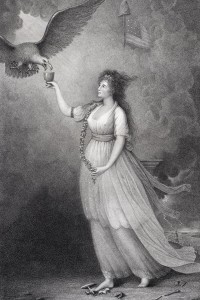Liberty in the Form of the Goddess of Youth (Engraving)
Artist/Maker: Edward Savage (1761-1817)
Created: 1796
Origin/Purchase: unknown
Materials: stipple engraving
Dimensions: 62.7 × 38.1 (24 3/4 × 15 in.)
Provenance: Thomas Jefferson Foundation
Historical Notes: Edward Savage's Liberty, a potent symbol of the triumph of the United States over tyranny, hung in the Parlor at Monticello among Jefferson's collection of historical, religious, and allegorical art.[1] Jefferson counted the preservation of liberty among those "sacred & undeniable" rights belonging to all men, and considered liberty to be above politics.[2] "[O]ur Attachment to no Nation upon Earth should supplant our Attachment to Liberty," Jefferson wrote in the 1775 "Declaration of the Causes and Necessity for Taking Up Arms."[3] He believed that the role of the United States was to promote liberty throughout the world.
Jefferson left no record of how he obtained this print, but it was probably available at Savage's Columbian Gallery on Chestnut Street in Philadelphia when Jefferson returned to that city in March 1797. As early as 1760 the Goddess of Liberty became associated with the American cause and was often depicted with figures representing the American continent, such as the Indian Princess. Gradually Liberty herself came to symbolize the young United States and she was often shown as she is in Savage's print, surrounded with icons such as the bald eagle, the American flag, the liberty pole, and the liberty cap, while trampling the symbols of monarchy.[4]
Edward Savage was an American-born artist who worked in Philadelphia, New York, and Boston, and traveled to England to study engraving. He is best known for his portraits of the Washington family. Jefferson's copy of Liberty is unlocated.
- Text from Stein, Worlds, 175
References
- ^ See Jefferson's Catalogue of Paintings &c., The Thomas Jefferson Papers, Accession #2958-b, Special Collections, University of Virginia Library. For a transcription of Jefferson's catalogue, see Seymour Howard, "Thomas Jefferson's Art Gallery for Monticello," The Art Bulletin 59, no. 4 (1977): 583-600.
- ^ Jefferson’s "original Rough draught" of the Declaration of Independence, June 11-July 4, 1776, in PTJ, 1:423. Transcription available at Founders Online.
- ^ Jefferson and John Dickinson, Declaration of the Causes and Necessity for Taking up Arms, July 6, 1775, in PTJ, 1:215. Transcription available at Founders Online.
- ^ E. McClung Fleming, "From Indian Princess to Greek Goddess: The American Image, 1783-1815," Winterthur Portfolio 3 (1967): 54. See also Marvin Trachtenberg, The Statue of Liberty (New York: Viking Press, 1976), 63-65.
